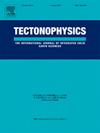Crustal structure of the Curnamona Province in Australia by ambient noise tomography
IF 2.7
3区 地球科学
Q2 GEOCHEMISTRY & GEOPHYSICS
引用次数: 0
Abstract
The Curnamona Province in southern Australia is a 90,000 km2 Paleoproterozoic to Mesoproterozoic craton that rifted from the Gawler Craton in the Neoproterozoic and is now separated by the Adelaide Rift Complex sediments in the Flinders Ranges. Three-component passive seismic data were collected over 30 days at 135 stations spaced approximately 25 km with sample rate of 2 ms and a natural frequency of 5 Hz. Cross-correlation functions of ambient noise were calculated between station pairs to determine dispersion curves at a period bandwidth of 3 to 9 s, from which a shear-wave velocity model was constructed to a depth of 20 km. In the top 5 km, low shear-wave velocity < 3400 m/s correlates with low electrical resistivity <100 Ohm.m from a broadband MT inversion of 134 co-located sites, primarily due to fluid-porosity of sediments. In the depth range 5–20 km there are two notable features. Firstly, across the southern part of the Curnamona Province shear-wave velocity increases by >200 m/s from west to east, over ∼200 km, correlated with a trend in Bouguer gravity that increases from −200 μm/s2 to +200 μm/s2. Secondly, there is weaker correlation in dip and spatial extent between a zone of low resistivity <10 Ohm.m and low shear-wave velocity < 3600 m/s. Higher density crust in the eastern margin of the Curnamona Province may be due to Paleoproterozoic-aged mafic crust that was originally subducted and then upthrust to shallower depths during the Olarian Orogeny from 1620 to 1580 Ma. Reduced shear-wave velocity coincident with low-resistivity in the crust may be related to grain-boundary graphitic Paleoproterozoic sediments that would be ductile with slightly lower shear-modulus and be electrically conductive.
澳大利亚库纳莫纳省地壳结构的环境噪声层析成像
澳大利亚南部的Curnamona省是一个90000平方公里的古元古代到中元古代克拉通,它从新元古代的Gawler克拉通中裂出,现在被弗林德斯山脉的阿德莱德裂谷复合体沉积物分开。三分量被动地震数据采集时间为30天,分布在135个站点,间隔约25公里,采样率为2 ms,固有频率为5 Hz。计算台站对间环境噪声相互关函数,确定周期带宽为3 ~ 9 s的频散曲线,并以此为基础构建深度为20 km的横波速度模型。在前5 km处,低横波速度<;3400m /s与低电阻率<;100欧姆相关。这主要是由于沉积物的流体孔隙度。在5-20公里的深度范围内,有两个显著的特征。首先,在整个Curnamona省南部,横波速度从西向东增加了200 m/s,超过200 km,与布格重力从−200 μm/s2增加到+200 μm/s2的趋势相关。其次,低电阻率<;10欧姆带在倾角和空间范围上的相关性较弱。M和低横波速度<;3600米/秒。库纳莫纳省东缘地壳密度较高,可能是由于1620 ~ 1580 Ma的奥拉良造山运动期间,古元古代基性地壳先是俯冲后上冲至较浅的地层。与地壳低电阻率一致的剪切波速降低可能与古元古代晶界石墨质沉积物有关,这些沉积物具有韧性,剪切模量略低,并具有导电性。
本文章由计算机程序翻译,如有差异,请以英文原文为准。
求助全文
约1分钟内获得全文
求助全文
来源期刊

Tectonophysics
地学-地球化学与地球物理
CiteScore
4.90
自引率
6.90%
发文量
300
审稿时长
6 months
期刊介绍:
The prime focus of Tectonophysics will be high-impact original research and reviews in the fields of kinematics, structure, composition, and dynamics of the solid arth at all scales. Tectonophysics particularly encourages submission of papers based on the integration of a multitude of geophysical, geological, geochemical, geodynamic, and geotectonic methods
 求助内容:
求助内容: 应助结果提醒方式:
应助结果提醒方式:


